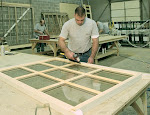
Re-View recently had a "Green" experience that could help many companies of all types.
We were founded 18 years ago on the basic principle of resisting the status quo, and are constantly searching for ways to advance our organization. Our plant manager had been reading several studies about how proper lighting can improve the quality of work and increase productivity. Given this information, he commissioned a study on how to effectively improve the lighting in our window plant. He was motivated to use efficient changes in lighting to improve the throughput in the plant. He was also convinced that increases in lighting in certain areas would reduce defects and rework.
What our plant manager didn't realize was how changes in light fixture and bulb technology could dramatically impact the electrical consumption of our plant. We brought in a lighting consultant who evaluated the current fixtures and the illumination throughout the facility. Our management then established target foot-candle ratings for the different areas of the plant, increasing the levels in areas where precision work was performed.
Like many production facilities constructed in the late 1960's, our plant has a combination of sodium vapor high bays and T12 fluorescent drop lights used to illuminate working areas. The lighting consultant quickly identified how we could achieve a three-year payback by replacing our existing system with six-lamp T5 fixtures. The team took a CAD drawing of our plant layout and established a lighting plan that would achieve 30 foot-candles in general areas and 50+ fc in areas where product detail is critical.
We recently tested the installation and discovered that in the assembly and fabrication areas of the plant where we used to have 15-20 fc, we now average 58-60 fc, and all shadows are eliminated. The aisles had 7 fc before the change and now are averaging 30 fc. Our plant employees are now asking for sunglasses and sunscreen.
The team at Re-View is always looking for ways to improve product quality and to reduce costs. We have invested in automated CNC fabrication equipment, computer-controlled saws, computerized glazing, and automated finishing systems. We came across many reports documenting improvements in productivity that were directly associated with changes in lighting. Since our windows are furniture-level quality, we were confident that advances in lighting would enable our craftsmen to perform better work. We also read reports about official improvements in employee satisfaction and safety due to upgrades in lighting. More information on the benefits of lighting can be found on this link: http://www.lightcorp.com/PDFs/industrial/learn/ImpactProductivity_DD1A8.pdf
What our team didn't realize was how advancements in lighting fixtures could also significantly reduce our electricity costs. We are going to recognize a payback on the investment in fixtures and the labor to install within the first three years. That is an amazing return especially since we aren't including the other effects of productivity and quality improvements that will certainly be achieved. Our results profoundly prove that Green building practices really do pay.






